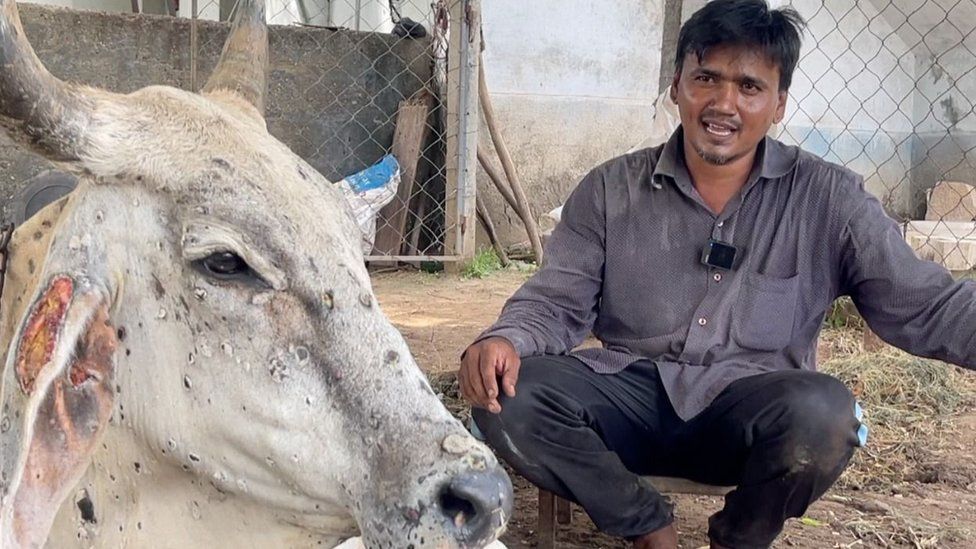Lumpy skin disease: Cattle farmers in Gujarat, Rajasthan reel under outbreak
- Published

"We treated our cows like family members," says a distraught Abbasbhai, who lives in the western Indian state of Gujarat.
Three of his 11 cows died in July after getting infected with lumpy skin disease, a viral infection that affects livestock. Three more of his cows are currently suffering from the disease.
Abbasbhai is one of thousands of cattle owners in Gujarat and at least three other Indian states - Rajasthan, Punjab and Himachal Pradesh - who are reeling from a severe outbreak of lumpy skin disease. The UN's Food and Agriculture Organization (FAO) has described it as "a vector-borne pox disease" that is "characterized by the appearance of skin nodules".
The infection is caused by the Capripox virus - which is genetically similar to the viruses that cause goat pox and sheep pox - and has been termed "an emerging threat to livestock worldwide" by health partnership Gavi, the Vaccine Alliance. Experts have said it is likely to infects cows at a higher rate than buffalos.
The disease was endemic in many African countries for years, and has spread to other parts of the world over the years. According to an FAO report, the disease first appeared in South Asia in July 2019, with Bangladesh reporting an outbreak. A month later, it was identified in India - which has the world's largest bovine population - and China.
The infection is usually transmitted by some species of mosquitoes, ticks and other blood-feeding insects.
"The disease causes lumps on the body of the animal and when flies and mosquitoes sit on them, they transfer the infection to other healthy animals," says Dr Ravi Israni, a senior veterinary official in Rajasthan state.
He adds that the outbreak may have worsened due to heavy rains in the monsoon season.
The disease can cause fever and sterility in cattle, and decrease milk production - a blow to many rural households, which depend on selling milk to make ends meet.
"The mortality rate of this disease is 1-5%," says Anil Virani, who works in the animal husbandry department in Gujarat.
More than 2,600 cattle in Gujarat have died so far from the disease according to official estimates - but ground reports by BBC Gujarati indicate the toll could be higher. Close to 6,000 animals have reportedly died in the neighbouring state of Rajasthan.
A distressed villager in Gujarat's Kutch district - which is one of the worst to be affected - told BBC Gujarati that "nearly 30-40 cows are dying every day".
Hundreds of animals are also suffering from the infection in the northern states of Punjab and Himachal Pradesh.
"We have seen that a vaccine for goat pox works against this disease and takes 15-20 days to become effective," Mr Virani says.
Farmers in both Rajasthan and Gujarat have alleged that the state governments didn't act fast enough to check the spread of the disease.
But administrative mechanisms in both states are in full swing now - Gujarat's agriculture minister Raghavji Patel said that the state government has vaccinated 300,000 cattle so far.
He added that the state was buying 1.1 million doses of the goat pox vaccine to make up for a shortfall.
Rajasthan has also been monitoring the affected districts and deploying additional resources to tackle the situation, BBC Hindi has reported.
In the meantime, Abbasbhai's day begins and ends with trying to treat his three cows that are suffering from the infection.
"I feel sad thinking about my cows that have died," he says.
"But I will continue to look after them as much as I can."
Reporting by Roxy Gagdekar Chhara and Sagar Patel, BBC Gujarati, and Mohar Singh Meena for BBC Hindi
- Published16 August 2021
- Published23 May 2022